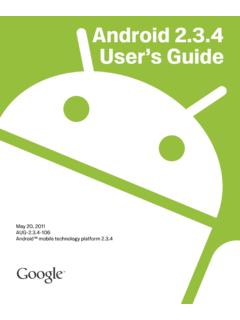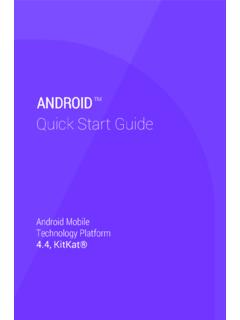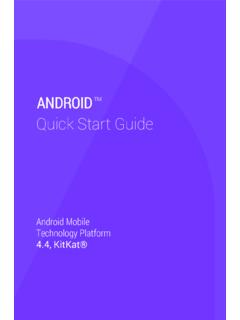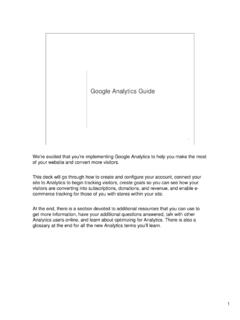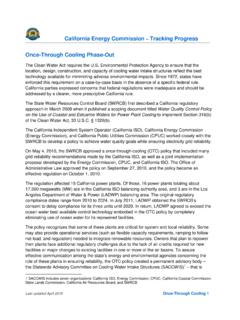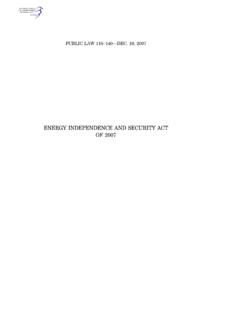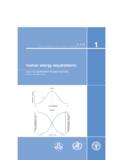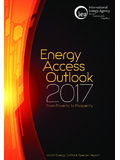Transcription of Google’s Green PPAs: What, How, and Why
1 Google s Green PPAs: What, How, and WhyIntroductionGoogle has pledged to reduce its carbon footprint to zero. Zero is an aggressive goal, not easily achieved by any one measure, so we pursue a multi-pronged approach to get there. Efficiency is one prong of the approach and carbon offsets is another. But a very important third prong of the approach is the purchase and use of carbon-free renewable electricity to power our data we started out on this path, we realized that we had a lot of learning to do. We had basic questions, such as: What types of resources are most appropriate, and from where? How do we get the electricity to our facility to use? How can we make such a purchase economical, and how can it be leveraged to protect us from higher prices in the future?
2 How can we maximize the impact of our Green power purchases on our carbon emissions and global emissions?We also knew we wanted to enforce some fundamental principles that we value:First, our activities must meet the basic criterion of additionality. We ll describe this more a bit further down, but fundamentally, a renewable energy purchase is additional if it has an effect in the real world, be it direct or indirect. A direct effect would be causing a new renewable project to be built. An indirect effect would be increasing demand for renewable energy such that market pressures are able to encourage new investment. Second, when possible, our projects should go beyond basic additionality and directly address problems that limit the growth of the renewable industry.
3 For example, if we know that we are going to need renewable energy for a long time, it may be better for renewable project developers if we commit to a long-term contract rather than purchasing as we go, because it makes it easier for them to raise paper attempts to show how we have answered these questions and met our principles in a way that makes business sense for us. We hope also that this will serve as a useful starting point for other companies that want to buy renewable , markets, and the art of the possibleElectronsFirst, a little background: We know from Kirchoff s circuit laws that electricity generated in one spot cannot be directed to a specific user over the electricity grid. Once you put electricity on the grid there is no actual way to know the energy from wind farm X is going to my data center Y.
4 Table of ContentsIntroduction ..1 Electrons, markets, the art of the possible ..1 Meeting our principles ..3 What Google actually does ..3 Why don t we do things in a different way?..4 September 17, 2013 | Revision 3 (initially published April 21, 2011)2 Given that you can t tell electrons where to go, how do you use and show your use of renewable energy ? One solution is to not use the grid at all. After all, we could put the renewable project behind the meter, meaning that it would be on the same premises as our data center. This is what is happening when people put solar panels on their roofs. It is also what we have done on our main campus in Mountain View, California, where our megawatt (MW) solar panel facility helps power our offices.
5 But this is not feasible for Google data centers (or most companies data centers) for a number of interrelated one, the area necessary to harness sufficient energy to power a data center by either method is much larger than the actual area of a data center and its surrounding property. Also, neither the wind nor the sun are constantly available resources. They come and go with the weather, while Google s data centers operate No matter what, we d need to be connected to the grid to access conventional power to accommodate our constant load. The plain truth is that the electric grid, with its mix of renewable and fossil generation, is an extremely useful and important tool for a data center operator, and with current technologies, renewable energy alone is not sufficiently reliable to power a data addition to these technical reasons why a behind-the-meter solution doesn t work for Google, there is a larger, and perhaps more important reason: there is no appreciable difference between putting a wind farm or solar facility behind our meter or on the grid.
6 At best the difference is one of appearance (Google would look greener ) and at worst it reduces the impact of our investment because a project built in a less favorable location would generate less energy over its life. Fundamentally, data centers and wind farms should each be sited where they can be most effective and this is often in different we know from physics that on a pooled electricity grid we can t tell if energy came from a Green or brown source, people do indeed claim to use electricity from a specific project at a specific location. Since this isn t generally technically possible, what do they mean? This is precisely the role of power markets, which are designed to track who should get paid for producing power and who should pay for using it.
7 For example, in Iowa, where we signed our first wind power purchase agreement (PPA), the power transmission authority MISO runs the wholesale power power market is pretty complicated, but fundamentally if you put in (generate) or take out (use) energy from a given location and at a particular time, you earn or pay a price specific to that location and time. If you want to move power from one place to another, you put it in at one location and get paid a location-specific price and take it out in the other and pay a potentially different location-specific price. Prices vary for a whole host of reasons, including where power is most needed, what power losses occur in moving the power to different locations, and how much power the transmission lines are transporting relative to their capacity.
8 In effect, the power market works independent of physics MISO can determine how much people pay or get paid per megawatt-hour (MWh), even if they aren t able to determine exactly which MWh they produced or used. This extends to so-called Green power: you can determine who should pay or be paid for producing or consuming Green power from a wind farm instead of brown power from a coal plant or natural gas plant, even though you can t possibly track flows of Green power through the grid. In the , this is often done through renewable electricity credits (RECs), which are a market-based means of keeping track of who produces and who uses Green electricity. One REC is created when a MWh of Green energy is generated and one REC is consumed when a user says they used a MWh of Green energy .
9 What s possibleA final important issue is access to these power markets, which is typically limited to wholesale entities like power utilities and generation companies. At our data centers, Google is a retail customer we have no way of taking power off the grid wholesale and applying it to our load. We have to buy power just like you do: from our local regulated And just like you, we have no control over where the utility gets its power they buy and generate (and sometimes sell excess electricity) on behalf of their customers. In some regions customers can choose the utility from which they purchase power. In many markets, including several locations where we operate data centers, there is no provision for an end user like Google to buy its own power directly from a renewable our principlesGiven the background above, let s recall what Google seeks to accomplish with renewable energy purchases.
10 There are two important goals: Our purchases should be additional. This means they should actually help to create more renewable power. Our investments should have the highest possible positive impact on the industry that they is a tricky concept. Perhaps it is easiest to give an example of what s not additional. Imagine a power company built a wind farm many years ago. They built it because they thought it was good business at the time, but the fact that it was a renewable resource was not important to their decision. They currently sell the power into the grid, and they re happy with their investment. Moreover, this power company has no plans to build any more wind farms. One day, they learn that Google is looking to purchase renewable electricity.

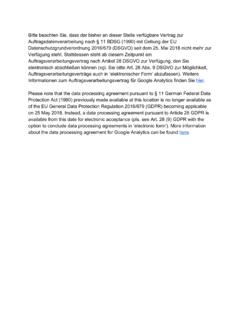
![[ A BEGINNER’S GUIDE ] - google.com](/cache/preview/6/3/0/2/d/a/6/2/thumb-6302da629d0e4b840982a7b28b399200.jpg)
